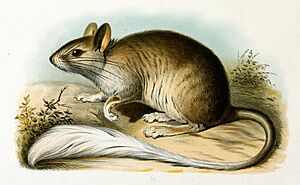Golden-backed tree-rat facts for kids
Quick facts for kids Golden-backed tree rat |
|
|---|---|
 |
|
| Conservation status | |
| Scientific classification | |
| Genus: |
Mesembriomys
|
| Species: |
macrurus
|
 |
|
| Historical range (light green) and current range (dark green) | |
| Synonyms | |
|
|
The golden-backed tree rat (Mesembriomys macrurus) is a type of rodent that lives only in Australia. It's known for the bright golden stripe of fur on its back. These special rats used to live all across Northern Australia. But now, you can only find them in a few remote places in the Kimberley region of Western Australia. They are also found in the Charnley River–Artesian Range Wildlife Sanctuary.
Contents
About the Golden-backed Tree Rat
Golden-backed tree rats get their name from a wide, golden stripe of fur. This stripe runs from the top of their head all the way to the base of their tail. Their tail also has a white, brush-like tip.
These rats are active at night and live in trees. During the day, they sleep in nests. They build these nests in hollow trees, thick bushes, or among rocks.
They are about 18 to 34 centimeters long, not including their tail. Their tail is even longer, from 29 to 36 centimeters. They usually weigh between 200 and 330 grams.
What They Eat
Golden-backed tree rats mostly eat fruits. They often travel through areas that have recently had bushfires to find these fruits. Their diet also includes flowers, grasses, and insects.
Reproduction and Life Cycle
Scientists believe golden-backed tree rats can have babies all year round. A mother rat is pregnant for about 48 days. She usually gives birth to two babies at a time. The young rats are ready to leave their mother when they are six or seven weeks old. In zoos, a golden-backed tree rat can live for up to 7.1 years.
Where They Live
The golden-backed tree rat is found only in Australia. It used to live in parts of the Northern Territory. However, recent searches have not found any golden-backed tree rats there. Local Aboriginal people from the Top End say the rats disappeared from that area around 2000 to 2010. Still, there is a small chance they might still be there.
In Western Australia, these rats once lived across parts of the Pilbara and the Kimberley. In the 1800s, they were very common in Broome. They were even seen as a pest because they would raid bags of rice and flour. But since 1903, they have only been found in wetter parts of the north-west Kimberley. They no longer live in the Pilbara or drier parts of the Kimberley.
Today, golden-backed tree rats live mainly in the north-west Kimberley region. This area is roughly between Kalumburu and Yampi Sound. They are found in places like the Artesian Range and Prince Regent National Park. They have also been seen in the Wunaamin Miliwundi Ranges. In 2012, they were found in the Mitchell Plateau for the first time. This suggests they might be slowly spreading in some areas.
Golden-backed tree rats also live on eleven islands off the Kimberley coast. These islands include Augustus, Buckle Head, and Uwins. We do not know the exact number of golden-backed tree rats alive today.
Protecting the Golden-backed Tree Rat
Their Status
The International Union for Conservation of Nature (IUCN) checks on animals around the world. On July 3, 2016, the IUCN said the golden-backed tree rat was a near-threatened species. This means it might become endangered soon. Before this, it was listed as "least-concern" in 2008 and "vulnerable" in 1996.
In Australia, the rat was listed as vulnerable from 2000 to 2019. In Western Australia, it is still considered vulnerable. But in the Northern Territory, it is listed as critically endangered. This means it is at a very high risk of disappearing there.
Dangers They Face
The biggest dangers to golden-backed tree rats are feral cats and bushfires. Large, hot bushfires that happen late in the dry season are especially harmful. These fires destroy the hollow trees and thick bushes where the rats build their nests. They also burn the fruit-bearing plants that the rats eat.
Other animals like cattle can also be a threat. They can change the environment by eating important food plants for the rats.
How We Can Help Them
In 2015, the Australian government suggested several ways to help protect golden-backed tree rats.
- A top priority is to create better ways to manage fires in the Kimberley region.
- Another important step is to keep track of the rat populations on the mainland and islands.
- It's also important to involve Aboriginal rangers and communities in these efforts.
Other ideas include keeping island populations safe from new threats. There is also a plan to bring golden-backed tree rats back to the Northern Territory.
The Charnley River-Artesian Range Wildlife Sanctuary protects many golden-backed tree rats. The Australian Wildlife Conservancy also works to help these rats. They have teamed up with the University of Tasmania to study how fires affect them.
In Culture
The Wunambal people, who are Indigenous Australians, have traditionally used the tails of golden-backed tree rats. They use them to make special necklaces.
Their Names
In the Wunambal language, golden-backed tree rats are called Koorrawal, Wunggangbarn, or Jari. The Yeidji people, who speak the Yiiji dialect of Wunambal, call it Jari Manya.
Another scientific name for Mesembriomys macrurus is Hapalotis boweri. This name was given by Edward Pierson Ramsay in 1887. He thought some specimens were a new species and named them after his friend, Thomas Henry Boyer-Bower.


